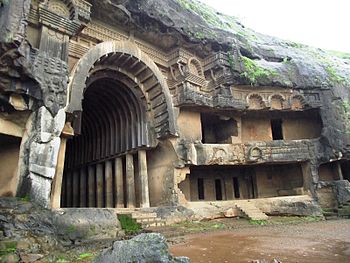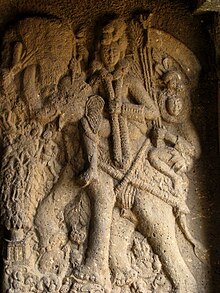Bhaja
Bhaja is an early Buddhist cave monastery consisting of 22 caves in the Indian state of Maharashtra . The complex is one of the oldest of its kind in all of India.
location
The caves are located on the Dekkan Plateau near an old caravan route about halfway between Mumbai and Pune and only about 3 km from Karli ; they are best reached from the small local train station in Malavli ( Marathi : मळवली) in about 30 minutes on foot.
history
About the history of the cave monastery, d. H. There are no written certificates about the construction time, donors, craftsmen, regional importance, etc.; Only on two vaulted rafters of the main hall and in the cistern were short inscriptions discovered, of which the first two date back to the 2nd century BC. To be dated. The dating of the earliest residential caves ( vihara ) and the main hall ( chaitya ) to the 3rd and / or 2nd century BC BC is based essentially on stylistic comparisons with the neighboring Buddhist caves of Karli and Bedsa.
architecture
Chaitya hall
The large apsidal worship hall ( chaitya ) with its largely preserved wooden false vault is the core structure of the Buddhist cave monastery of Bhaja; it is divided into a wide central nave and two narrow side aisles by 27 slightly inclined octagonal pillars, which have neither bases nor capitals. The entire room is approx. 17 m long and approx. 8 m wide; he has no decoration whatsoever. The high vault carved out of the rock is z. Some of the teak beams are more than 2000 years old. The stupa in the apse area of the hall - also carved out of the rock and around 3.50 meters high - is barely structured, but is still elevated by the fence ( harmika ) of a formerly existing umbrella ( chhatri ). Due to the presence of a side aisle, the Buddhists can walk around ( pradakshina ) around the stupa both directly and indirectly. However, it is possible that (at least in the early days of the monastery) walking around and touching the stupa was reserved only for monks or other high-ranking people.
Vihara caves
The other caves of Bhaja are mostly - communally used - residential caves ( viharas ) with small sleeping chambers carved out of the walls, in which the raised stone beds can sometimes still be seen. Some of the caves were perhaps (in later times) used as hostels for pilgrims and passing merchants, whose alms and donations were always welcome, because in the wider area of the monastery there were only a few small villages whose inhabitants did not have daily residents in the long run Could or wanted to ensure care for the mendicant monks. Nevertheless, the operation of the monastery had to be maintained and financed somehow.
function
The viharas were also painstakingly carved out of the rock. Most of these caves form a large square common room with adjoining small sleeping cells. The walls, ceiling and floor of the main room were smoothed as well as possible, the cells, on the other hand - with the exception of the stone bed - were only roughly worked. The room and cells were originally completely unadorned; In later times, however, small stupas or Buddha images were sometimes carved out of the rock chambers and ceilings and walls were smoothed with stucco and painted. Some of the small cells (e.g. in cave 5) have ornate entrances - perhaps they were intended for high-ranking monks or for visitors and guests.
Reliefs in cave 19
In Vihara Cave No. 19 there are two extraordinary - and certainly not until later (3rd / 4th century AD) - made reliefs (see web link), possibly the two opposing (?) Maharajas (turban) but also show the Vedic sun god Surya (left) and the main Vedic god Indra (right); it would be the earliest surviving representations of the two Hindu gods in all of India. Noteworthy, but not unusual, is the fact that Hindu figures can be seen in a Buddhist monastery - both religions coexisted peacefully in India for centuries.
- Surya (?)
The left of the two - unfortunately not well preserved - reliefs possibly shows Surya on his sun chariot drawn by four horses, which is worked like an antique single-axle chariot. The main character's visible forearm is in a cuff; the reins hang down slightly. Below the horses lies a curved, bulky figure with a head that is barely recognizable - perhaps a defeated enemy or a demon. The god's hair is covered with a turban twisted several times; hanging earrings and a double-wound garland around the neck form the jewelry. To the left of the main character, a servant holds a fly whisk in his hand. Between this figure and the god there is an umbrella - a sun protection as well as a badge of honor or national emblem.
- Indra (?)
The relief to the right of the doorway shows perhaps the god Indra, Surya's brother, riding an elephant, who is seizing a tree with his trunk; a person seems to fall upside down. A large number of people can be seen below the elephant and in front of it - it is unclear whether they are escorting or fleeing opponents. In his right hand Indra holds an elephant stick ( ankus ) with which commands were transmitted to the animal. In his left hand he holds a garland of flowers hanging from his neck; he wears a cuff around his wrist. Head and ear jewelry resemble the Surya figure on the opposite side. Behind Indra sits a servant with a flag and palm fronds that were used as air fans; he wears a strange ragged skirt around his waist. The door frame is included in the scene; a tree surrounded by a fence ( harmika ) can be seen in front of the right foot and below the left foot of the elephant . The elaborately knotted turban of the god is reminiscent of similar headgear from the Shunga period or of images of the vedika fence on the stupa of Bharhut ; these are mostly in the 2nd century BC. Dated.

Jali window
Carved out of a natural stone wall is a simple Jali window that is one of the earliest surviving examples of its kind and certainly contributed little to the lighting of the space behind it, but was rather meant to be purely decorative. The frame is slightly profiled; the two-level window filling is based on - not preserved - wooden or braided models. Comparable - albeit closed - wall motifs can be found in the dwelling cave ( vihara ) of the nearby cave monastery of Bedsa . Other early stone grids of this type are found in the Mahakali Caves north of Mumbai.
Votive stupas
Under a rock ledge or directly in front of it, 14 votive or memorial stupas hewn out of the rock stand close together. The unusual facility is sometimes referred to as a kind of 'graveyard'; However, no relics or their containers were found. Two of the stupas have short Sthavira inscriptions that refer to the Orthodox 'teaching of the ancients'.
meaning
Most researchers tend to believe that the Chaitiya Hall of Bhaja is the oldest of its kind in all of India. The inclined pillars and the wooden false vaults refer to earlier free-standing wooden structures, the existence of which can be assumed to be certain, but of which nothing has survived.
Surroundings
The Buddhist cave monasteries of Karli and Bedsa are only a short distance from Bhaja (3 and 12 km respectively) .
See also
literature
- Bernd Rosenheim: The world of the Buddha. Early Buddhist Art Sites in India . Philipp von Zabern, Mainz 2006 ISBN 3-8053-3665-9
Web links
- Bhaja - Archaeological Survey of India (Engl.)
- Cave monasteries of Karli and Bhaja with card (Engl.)
- Photo of the reliefs in cave 19 etc.
Coordinates: 18 ° 43 ′ 40 ″ N , 73 ° 28 ′ 55 ″ E



